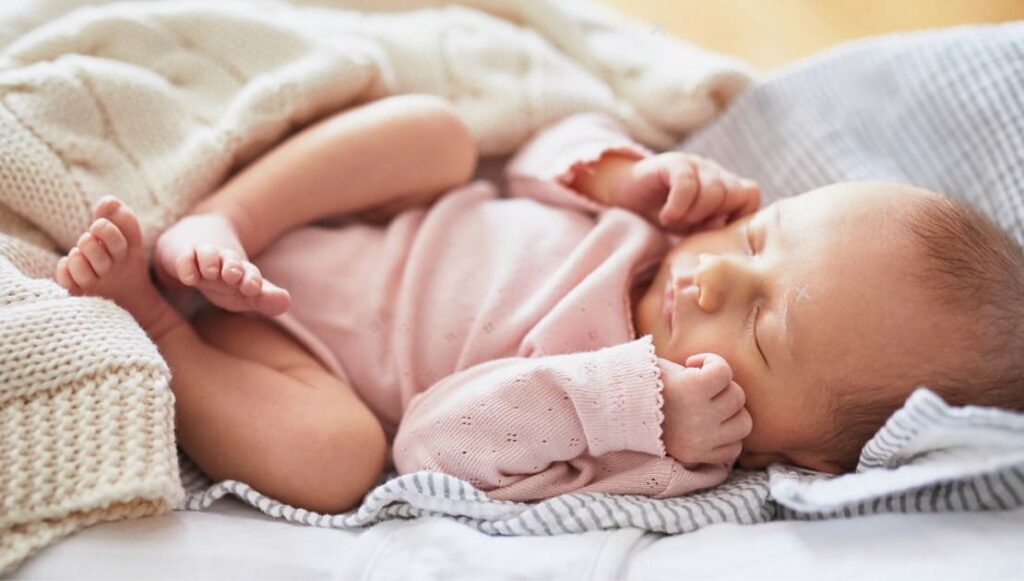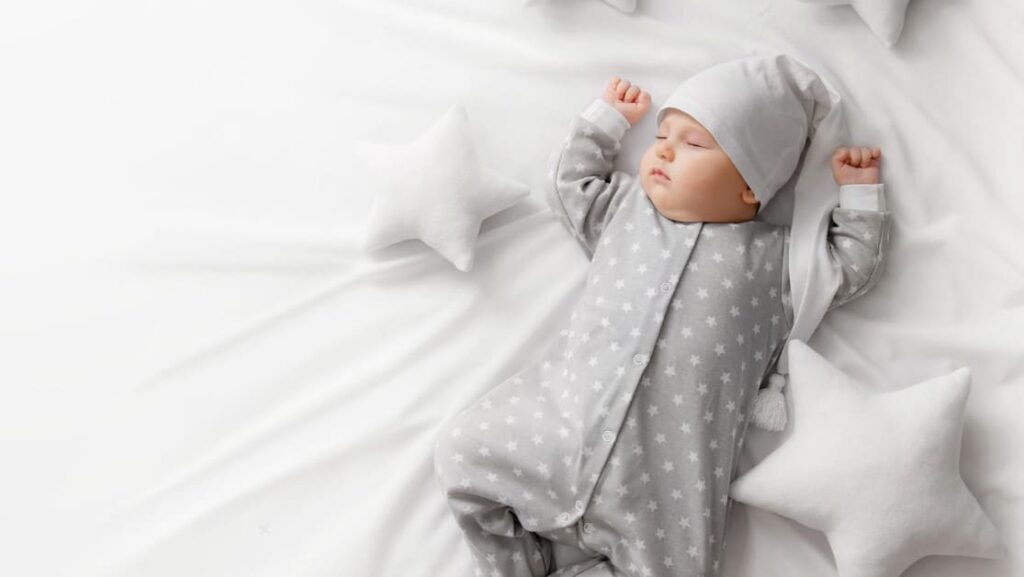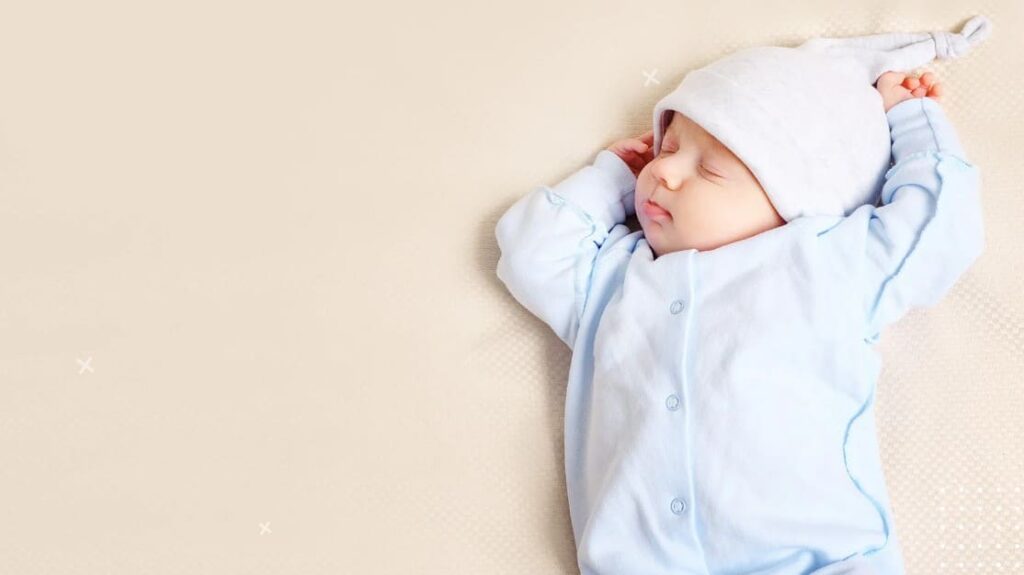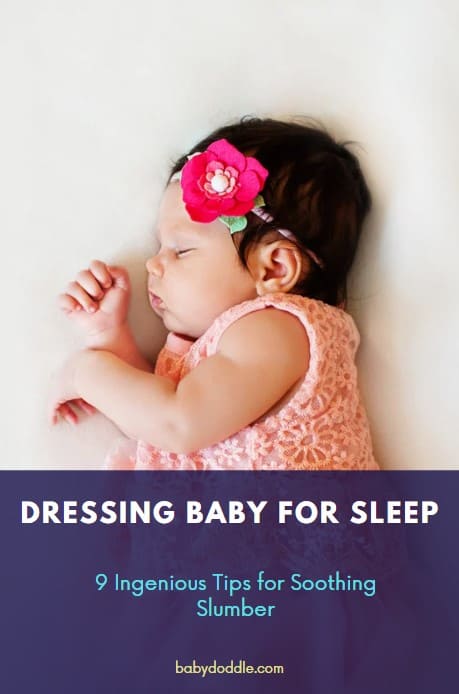Getting your little one dressed and ready for a good night’s sleep can feel like a delicate dance – you want to ensure they’re cozy and comfortable, but not too warm or too cold. As parents, we’ve all been there, haven’t we? Staring at our baby’s dresser, wondering, “How in the world do I dress my child for sleep?”
Well, fear not, fellow sleep-deprived mamas and papas! I’m here to share 9 ingenious tips that will have your baby drifting off to dreamland in no time. With a little know-how and the right sleepwear, you can say goodbye to those endless nights of tossing, turning, and frantic middle-of-the-night wardrobe changes.
Let’s dive in, shall we?

Understanding the Basics of Dressing Baby for Sleep
When it comes to dressing your little one for sleep, there are a few key factors to keep in mind: temperature, fabric, fit, and safety. Getting the right balance is essential for ensuring your baby stays comfortable and safe throughout the night.
First and foremost, temperature regulation is crucial. Babies, being the tiny thermoregulators that they are, can’t always control their body temperature as efficiently as we can. That’s why it’s important to dress them in layers that can be easily added or removed depending on the room temperature. A good rule of thumb is to dress your baby in one more layer than you would wear yourself in the same environment.
The fabric of your baby’s sleepwear is also important. Opt for natural, breathable materials like cotton or bamboo that will wick away moisture and allow your little one’s skin to breathe. Avoid anything too tight or restrictive, as this can interfere with their comfort and sleep quality.
Speaking of fit, it’s crucial to find that sweet spot between snug and loose. You want the sleepwear to be cozy and secure, but not so tight that it could potentially cause overheating or respiratory issues. Remember, babies move a lot in their sleep, so a little extra room for maneuverability is a good thing.
And last but not least, safety should always be your top priority. Steer clear of any sleepwear with detachable parts, loose strings, or loose-fitting hoods that could pose a suffocation risk. Opt for well-designed, age-appropriate sleepwear that will keep your little one secure and snug throughout the night.
| Age | Ideal Room Temperature Range |
|---|---|
| Newborn (0-3 months) | 68°F – 72°F (20°C – 22°C) |
| Infant (3-6 months) | 68°F – 72°F (20°C – 22°C) |
| Older Infant (6-12 months) | 68°F – 72°F (20°C – 22°C) |
| Toddler (1-3 years) | 68°F – 72°F (20°C – 22°C) |
Choosing the Right Sleepwear for Optimal Sleep
Now that we’ve covered the basics, let’s talk about the different sleepwear options available for your baby. From onesies and footed pajamas to sleep sacks and wearable blankets, the choices can be overwhelming. The key is to select sleepwear that will provide the right level of warmth and comfort for your little one’s slumber.
Onesies and footed pajamas are classic choices for newborns and infants. They offer full-body coverage, which can be particularly helpful for keeping tiny toes toasty. Just be mindful of the fabric and fit, ensuring it’s not too tight or restrictive.
For a bit more versatility, consider a sleep sack or wearable blanket. These cozy garments allow for easy temperature regulation, as you can simply adjust the layer thickness based on the room temperature. They also provide a sense of security and coziness that can be incredibly soothing for babies.
When selecting sleepwear for different seasons, keep in mind the general rule of thumb: dress your baby in one more layer than you would wear yourself. In the cooler months, opt for long-sleeved footed pajamas or a thicker sleep sack. As the weather warms, switch to short-sleeved onesies or a lighter, breathable sleep sack.
No matter which sleepwear you choose, be sure to check the fit regularly. Babies grow quickly, and what once fit snugly may soon become too tight or too loose. Regularly monitoring the fit will help ensure your little one stays comfortable and safe throughout the night.
| Fabric Type | Pros | Cons |
|---|---|---|
| Cotton | Breathable, soft, hypoallergenic | Can lose insulation when wet |
| Bamboo | Breathable, moisture-wicking, hypoallergenic | Can be more expensive |
| Wool | Naturally temperature-regulating, durable | Can be itchy for some babies |
| Silk | Lightweight, hypoallergenic | Can be more delicate and expensive |
| Polyester | Durable, easy to clean | Can be less breathable |
Dressing Tips for a Peaceful Bedtime Routine
Dressing your baby for sleep is not just about selecting the right sleepwear – it’s also an integral part of your little one’s bedtime routine. By incorporating dressing into a calming, consistent routine, you can help ease the transition from playtime to dreamtime.
Start by setting the stage for a peaceful environment. Dim the lights, play some soothing music, and consider using a white noise machine to help block out any disruptive sounds. This sensory cue will signal to your baby that it’s time to start winding down.
As you begin the dressing process, speak in a soft, soothing tone. Narrate what you’re doing, using gentle touches and comforting motions. This not only helps your baby feel secure and relaxed, but it also reinforces the routine, making it easier for them to associate dressing with sleep.
If your little one tends to resist the dressing process, try incorporating a few of their favorite things. Perhaps they have a special stuffed animal or blanket that they love to cuddle with. Letting them hold onto their beloved item can make the experience more enjoyable and less stressful.
Remember, the key to a successful bedtime routine is consistency. By following the same steps in the same order every night, you’ll help your baby’s brain and body prepare for the transition to sleep. Before you know it, the mere act of getting dressed for bed will become a signal to your little one that it’s time to start snoozing.

9 Ingenious Tips for Soothing Slumber
Now that we’ve covered the basics, let’s dive into the 9 ingenious tips that will have your baby drifting off to dreamland with ease:
- Opt for Soft, Breathable Fabrics: As we mentioned earlier, natural materials like cotton and bamboo are ideal for baby sleepwear. These fabrics are gentle on delicate skin and allow for optimal airflow, preventing overheating and discomfort.
- Dress in Comfortable, Loose-Fitting Layers: Layering is key when it comes to regulating your baby’s temperature. Opt for items that can be easily added or removed, such as a onesie paired with a sleep sack or a short-sleeved pajama top and bottoms.
- Consider Room Temperature When Selecting Sleepwear: The ideal room temperature for sleeping babies is between 68°F and 72°F. Dress your little one accordingly, using the “one more layer than you” rule as a general guideline.
- Avoid Over-Bundling or Under-Dressing: It’s a delicate balance, but you’ll want to steer clear of both extremes. Over-bundling can lead to overheating, while under-dressing can cause your baby to feel cold and uncomfortable.
- Ensure a Snug, Yet Flexible Fit to Prevent Entanglement: You want the sleepwear to be cozy and secure, but not so tight that it restricts movement or breathing. Leave a little room for your baby to move freely without getting tangled up.
- Choose Sleepwear with No Loose Parts or Detachable Pieces: Safety should always be your top priority. Opt for well-designed, age-appropriate sleepwear that won’t pose a suffocation risk.
- Incorporate Familiar, Comforting Elements into Sleepwear: Does your baby have a favorite stuffed animal or cozy blanket? Consider choosing sleepwear that features a similar texture or pattern to help soothe them to sleep.
- Establish a Consistent Dressing Routine for Bedtime: As we discussed earlier, incorporating dressing into a calming bedtime routine can work wonders for your baby’s sleep. Follow the same steps in the same order each night to help cue their brain and body.
- Monitor Your Baby’s Comfort and Adjust as Needed: Pay close attention to your little one’s cues, such as flushed cheeks, sweating, or shivering. If you notice any signs of discomfort, make adjustments to their sleepwear until they seem content and cozy.
Remember, every baby is unique, so don’t be afraid to experiment to find the perfect sleep attire and routine that works best for your little one. With a little trial and error, you’ll soon have your baby sleeping soundly through the night.
Understanding Baby Sleep Needs by Age
As your baby grows, their sleep needs and patterns will evolve. Understanding these age-specific requirements can help you adjust their sleepwear accordingly for optimal rest.
Newborns (0-3 months): Newborn babies sleep a lot – up to 17 hours a day! During this stage, they’ll need cozy, full-body coverage to help regulate their body temperature. Footed pajamas or a lightweight sleep sack are great options.
Infants (3-6 months): As your baby hits the 3-month mark, they’ll start spending less time sleeping. However, they still require 14-15 hours of shut-eye per day. Opt for breathable, short-sleeved onesies or two-piece pajama sets to allow for more movement.
Older Infants (6-12 months): Around 6 months, your baby’s sleep needs will start to decrease again, with 12-14 hours of sleep per day being the norm. Stick to loose-fitting, short-sleeved pajamas or sleep sacks to ensure comfort and airflow.
Toddlers (1-3 years): Toddlers typically require 11-14 hours of sleep per day. During this stage, you can start incorporating their personal style preferences into their sleepwear, such as their favorite characters or colors.
Safe Sleep Practices for Babies of All Ages
Dressing your baby for sleep is just one piece of the puzzle when it comes to ensuring their safety and wellbeing. Here are some essential safe sleep practices to keep in mind:
Room Temperature: Maintain a cool, comfortable room temperature, typically between 68-72°F (20-22°C). Avoid overheating, as it can increase the risk of SIDS.
Bedtime Routine: Establish a consistent bedtime routine to help your baby’s body and brain prepare for sleep. This can include activities like a warm bath, gentle massage, and reading a calming story.
Swaddling (For Younger Babies): Swaddling can be a great way to help soothe newborns and young infants, but it’s important to discontinue the practice once they start showing signs of being able to roll over.
Keep their Head Uncovered: Make sure your baby’s face and head remain uncovered during sleep to allow for proper airflow and prevent overheating.
Monitor their Temperature: Check your baby’s skin periodically to ensure they’re not too hot or too cold. Adjust their sleepwear accordingly if needed.
Dressing Baby for Sleep in Specific Scenarios
While the basic principles of dressing your baby for sleep remain the same, there are a few special considerations to keep in mind for specific situations:
When Traveling or Going on Vacation: Packing versatile, easy-to-layer sleepwear can be a lifesaver when you’re on the go. Choose fabrics that are lightweight and easy to clean, and don’t forget to research the climate of your destination to ensure you have the right attire.
For Sleepovers or Daycare: When your little one is spending the night somewhere other than home, be sure to provide clear instructions and any special sleepwear they may need. This will help ensure their comfort and safety, even when you’re not there.
During Illness: If your baby is under the weather, they may have a higher or lower body temperature than usual. Dress them in breathable, moisture-wicking fabrics and be prepared to adjust layers as needed.
When Transitioning Between Seasons: As the weather changes, you’ll need to adapt your baby’s sleepwear accordingly. When moving from winter to spring, for example, gradually lighten up the layers to prevent overheating.

Common Dressing Mistakes to Avoid
As parents, we’ve all been there – staring at our baby’s dresser, second-guessing our choices and wondering if we’re doing it all wrong. But fear not, friends! I’m here to help you avoid some common pitfalls when it comes to dressing your little one for sleep.
One of the most common mistakes is over-bundling. It’s understandable to want to keep your baby as cozy as possible, but too many layers can lead to overheating and discomfort. Remember, babies regulate their body temperature differently than we do, so they’re more prone to getting too warm.
Another common misstep is under-dressing. If your baby is shivering or feeling chilly, it’s a clear sign that they need an extra layer or two. Don’t be afraid to add socks, a sleep sack, or even a lightweight swaddle to ensure they stay toasty.
Improper fit is another dressing dilemma that can crop up. Sleepwear that’s too tight can restrict movement and breathing, while anything too loose can pose a safety risk. Take the time to check the fit regularly and make adjustments as your little one grows.
Finally, be mindful of any loose or detachable parts on your baby’s sleepwear. Strings, buttons, and other small pieces can become a choking hazard, so always opt for well-designed, age-appropriate garments that prioritize safety.
The key is to pay close attention to your baby’s cues and adjust their sleepwear accordingly. With a little practice and patience, you’ll soon become a pro at dressing your little one for a restful night’s sleep.
Addressing Common Dressing Concerns
As parents, we often have questions and concerns when it comes to dressing our little ones for sleep. Here are some solutions to some of the most common issues:
How Do I Know if My Baby is Too Hot or Too Cold? Pay attention to your baby’s skin tone, breathing, and overall behavior. Flushed cheeks, sweating, or shivering are all signs that you may need to make adjustments to their sleepwear.
Are Baby Monitor Temperatures Accurate? While baby monitors can provide a general indication of the room temperature, they may not always be entirely accurate. Use a separate, reliable thermometer to ensure you have an exact reading.
Should Newborns Wear Hats to Sleep? In general, it’s best to avoid putting hats on newborns while they sleep, as this can increase the risk of overheating. The exception would be if your baby was born prematurely and their care team recommends it.
How Many Layers Should a Newborn Wear? As a general rule, dress your newborn in one more layer than you would wear yourself in the same environment. This helps account for their less-developed temperature regulation abilities.
When to Seek Professional Advice
As parents, we all want to do what’s best for our babies, but sometimes, even with our best efforts, we may encounter persistent sleep issues or concerns. In those cases, it’s important to know when to seek out the guidance of a professional.
If you’ve tried adjusting your baby’s sleepwear, room temperature, and bedtime routine, but they’re still struggling to sleep soundly, it may be time to consult with your pediatrician. They can help rule out any underlying medical conditions and provide personalized recommendations to get your little one’s sleep back on track.
Additionally, if you have any doubts or concerns about the safety of your baby’s sleepwear or sleep environment, don’t hesitate to reach out to a sleep specialist or child sleep consultant. These experts can offer valuable insights and tailored solutions to ensure your little one is sleeping safely and soundly.
Remember, every baby is unique, and what works for one may not work for another. By working closely with healthcare professionals, you can gain the peace of mind and confidence you need to help your baby get the restful sleep they need to thrive.
Wrapping Up: Embracing the Journey of Dressing Baby for Sleep
As you can see, dressing your baby for sleep is a delicate balancing act, but with the right tips and a bit of practice, you’ll be a pro in no time. Remember, the key is to focus on temperature regulation, fabric choice, and a snug yet flexible fit – all while keeping safety as your top priority.
By incorporating dressing into a consistent bedtime routine, you can help ease the transition to dreamland and ensure your little one gets the quality sleep they need to grow and develop. And don’t be afraid to experiment and find what works best for your unique bundle of joy.
So take a deep breath, mama and papa, and embrace the journey of dressing your baby for sleep. With a little bit of know-how and a whole lot of love, you’ve got this! Sweet dreams, little one.
FAQ – Dressing Baby for Sleep
What is the ideal room temperature for a baby sleeping?
The ideal room temperature for a baby sleeping is generally between 68°F and 72°F (20°C and 22°C). This temperature range helps ensure your little one stays comfortable and doesn’t get too hot or too cold. Newborns and younger infants have a harder time regulating their body temperature, so it’s important to monitor the room and adjust their sleepwear accordingly. As your baby gets older, from around 6 months and up, you can be a bit more flexible with the room temperature, as long as they seem content and cozy in their sleepwear.
How many layers should a newborn wear to sleep?
When dressing a newborn for sleep, a good rule of thumb is to dress them in one more layer than you would wear yourself in the same environment. This helps account for their less developed ability to regulate their body temperature.
For example, if you’re comfortable wearing a long-sleeved shirt and light pants, you would want to dress your newborn in a footed sleeper or onesie plus a lightweight sleep sack. The key is to avoid over-bundling, which can lead to overheating, as well as under-dressing, which can cause your little one to feel cold.
Remember to also consider the room temperature and adjust the layers accordingly. Pay close attention to your newborn’s cues, such as flushed cheeks or sweating, to ensure they’re not too warm.
Should newborns wear hats to sleep?
In general, it’s best to avoid putting hats on newborns while they sleep. Newborns have a higher risk of overheating, and a hat can trap additional heat and interfere with their ability to regulate their body temperature.
The exception would be if your newborn was born prematurely or has a medical condition that requires their head to be covered during sleep. In these cases, your pediatrician or neonatal care team would provide specific guidance on the appropriate use of hats or other headwear.
For healthy, full-term newborns, it’s usually sufficient to ensure their head, face, and neck remain uncovered during sleep to promote proper airflow and prevent overheating. Focus instead on dressing your newborn in cozy, breathable sleepwear that covers their body without restricting movement or airflow.
How do I know if my baby is too hot or too cold while sleeping?
Monitoring your baby’s comfort and temperature during sleep is crucial. Here are some signs to look for:
Too Hot:
- Flushed, red cheeks
- Sweating
- Rapid breathing
- Feeling clammy to the touch
Too Cold:
- Hands and feet feel cool to the touch
- Shivering or trembling
- Crying or restlessness
If you notice any of these signs, make adjustments to your baby’s sleepwear or the room temperature. The goal is to keep them in a comfortable, neutral thermal zone where they aren’t sweating or shivering.
Remember, every baby is different, so pay close attention to your little one’s unique cues and adjust as needed. If you’re ever unsure, it’s always better to err on the side of caution and add or remove a layer.
What are some safe sleep practices I should follow?
In addition to dressing your baby properly for sleep, there are several other safe sleep practices to keep in mind:
- Maintain a cool, comfortable room temperature between 68-72°F (20-22°C)
- Establish a consistent bedtime routine to help your baby’s body and brain prepare for sleep
- Discontinue swaddling once your baby shows signs of being able to roll over
- Keep your baby’s head and face uncovered during sleep to allow for proper airflow
- Regularly check your baby’s temperature and adjust their sleepwear as needed
- Invest in a reliable room thermometer, as baby monitors may not always provide accurate readings
Following these safe sleep guidelines, along with the tips for dressing your baby, will help ensure your little one enjoys restful, comfortable slumber throughout the night.












